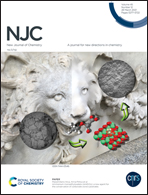Rapid iodine adsorption from vapor phase and solution by a nitrogen-rich covalent piperazine–triazine-based polymer†
Abstract
The efficient capture of radioiodine from the waste of nuclear industries is a growing priority for the safe development of nuclear energy. However, because the iodine adsorption rate of previously reported adsorbents is very slow, they are inadequate for use in an actual emergency such as radioiodine leakage in a nuclear accident. Herein, a nitrogen-rich covalent triazine–piperazine-based porous polymer (n-CTP) was successfully synthesized via a mild one-step solvothermal route. The large pore size and abundant N-heterocyclic groups (with a nitrogen content as high as 39.69%) of n-CTP are beneficial for the diffusion and adsorption of I2, and they have the ability to decrease the adsorption time. The ability of n-CTP to adsorb iodine vapor was examined, and the results show that n-CTP possesses a faster adsorption rate (1.58 g g−1 h−1) than most iodine-capturing covalent organic polymers (COPs), excellent iodine uptake capacity (4.19 g g−1), satisfactory selectivity, and can be reused for at least three cycles without a significant loss of iodine uptake. FT-IR and Raman analyses revealed that the mechanism of iodine capture is attributed to the charge transfer interactions between n-CTP and the guest iodine. In addition, n-CTP also exhibits high iodine capture capacity (2.88 g g−1) and fast adsorption rate in iodine solutions. Thus, n-CTP has the potential to be applied to the rapid removal and enrichment of radioiodine in spent fuel reprocessing and has the ability to prevent environmental contamination in the case of nuclear accidents.



 Please wait while we load your content...
Please wait while we load your content...